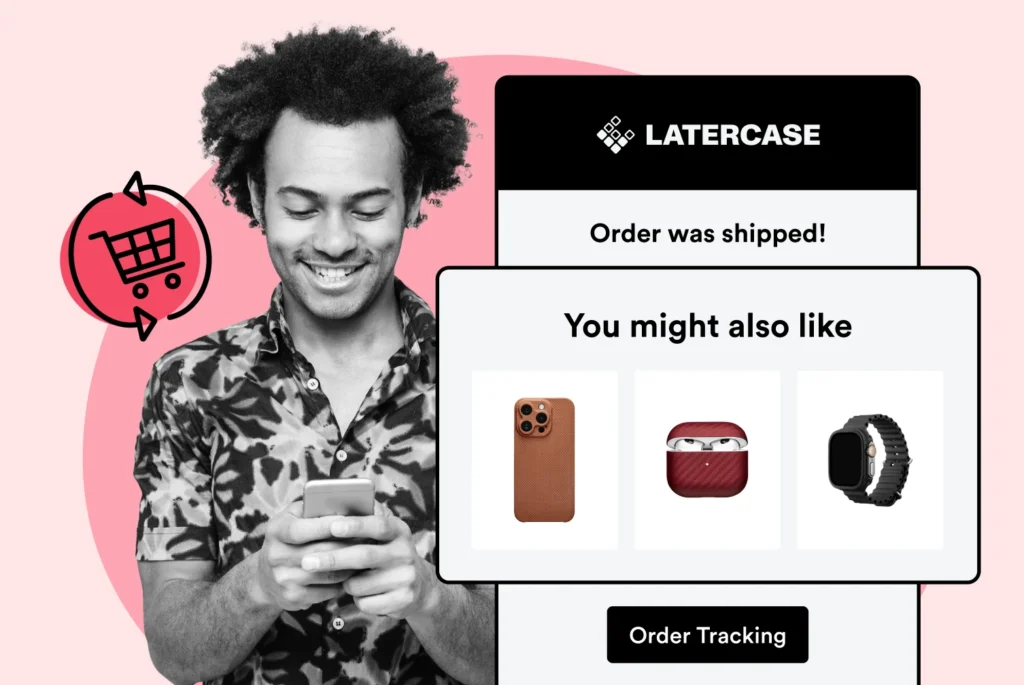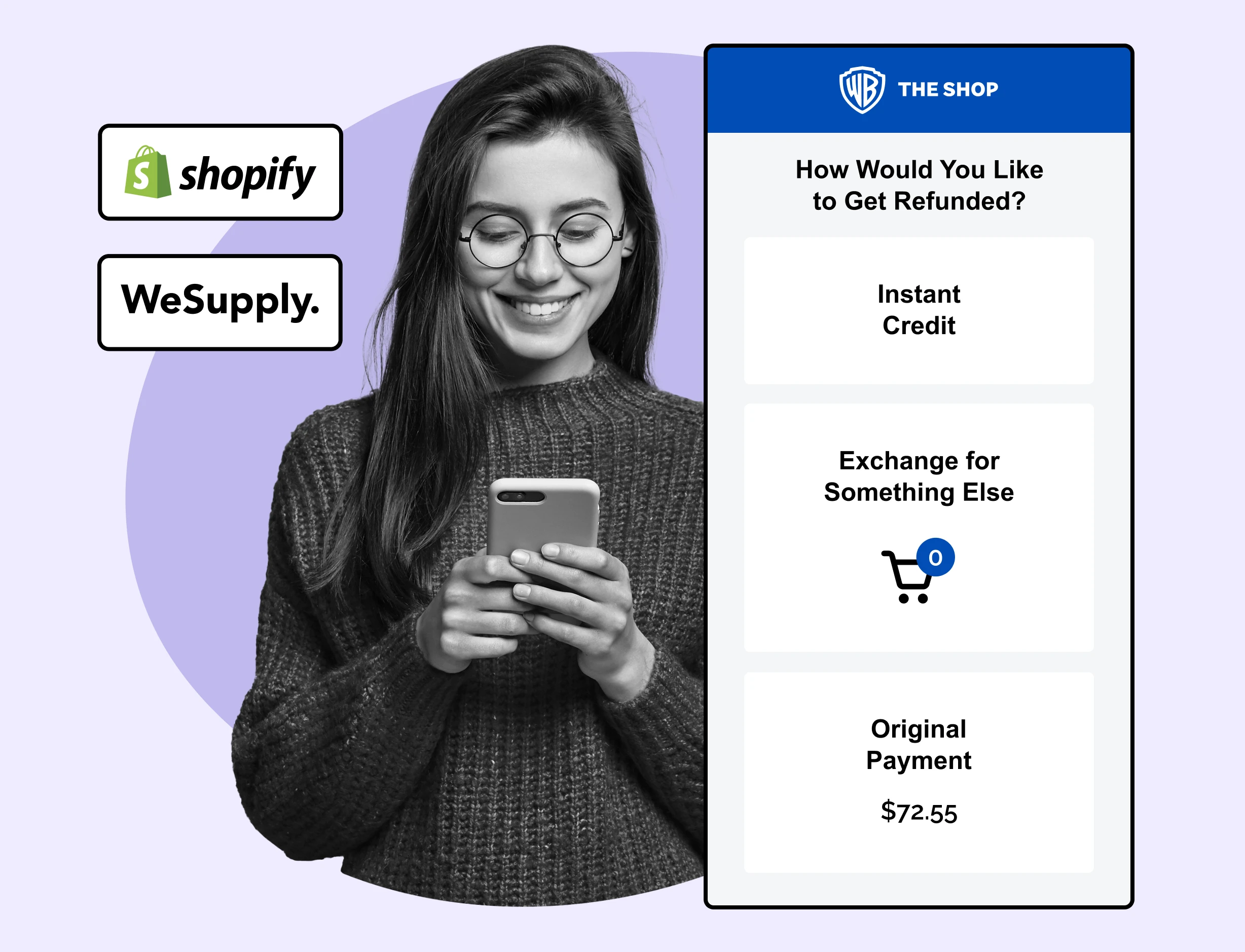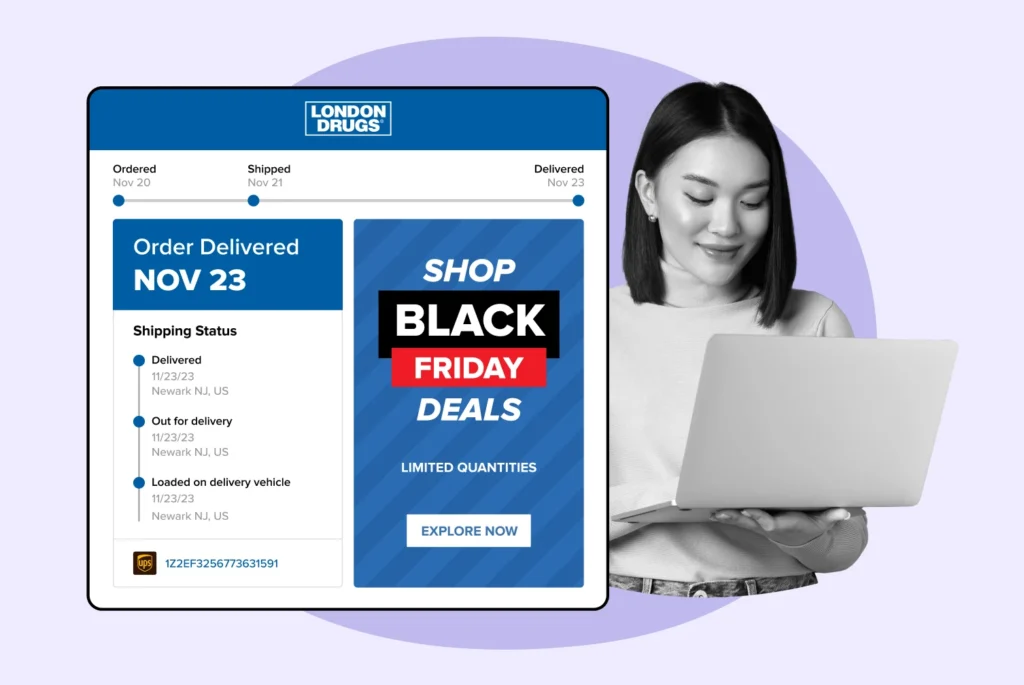
Boost Ecommerce Sales: 9 Effective Ways to Increase Sales
Prepare to exceed customer expectations and supercharge your sales with practical tactics that will elevate your e-commerce business!
Shipping, Tracking & Notifications
Boost customer experience and reduce support tickets
Realtime order and shipment tracking
Proactive order and shipping notifications
AI-Enhanced Discounted Labels
Predictive pre-purchase estimated delivery dates
Self-Serivce branded order tracking
Effortless experience delivered
Identify and Resolve Order Issues
Realtime order and shipment tracking
Make returns profitable and delight customers
Flexibility to define any return destinations & conditions
Simplify returns for your customers and team
Incentivize exchanges over returns
Returns management made easy for your team
Returns management made easy for your team
Easy claims and smart upsells
Understand why your customers are returning
In-Store & Curbside Pickup
Unify the online and the in-store experience
Hassle-free pickup experience for customers
In-Store dashboard to keep operations streamlined
In-Store and Online orders unified
Drive foot-traffic to your stores
Shipping, Tracking & Notifications
Boost customer experience and reduce support tickets
Realtime order and shipment tracking
Proactive order and shipping notifications
AI-Enhanced Discounted Labels
Predictive pre-purchase estimated delivery dates
Self-Serivce branded order tracking
Effortless experience delivered
Identify and Resolve Order Issues
Realtime order and shipment tracking
Make returns profitable and delight customers
Flexibility to define any return destinations & conditions
Simplify returns for your customers and team
Incentivize exchanges over returns
Returns management made easy for your team
Returns management made easy for your team
Understand why your customers are returning
In-Store & Curbside Pickup
Unify the online and the in-store experience
Hassle-free pickup experience for customers
In-Store Dashboard to keep operations streamlined
In-Store and Online orders unified
Drive foot-traffic to your stores
Boost customer experience and reduce support tickets
Realtime order and shipment tracking
Proactive order and shipping notifications
AI-Enhanced Discounted Labels
Predictive pre-purchase estimated delivery dates
Self-Serivce branded order tracking
Effortless experience delivered
Make returns profitable and delight customers
Flexibility to define any return destinations & conditions
Simplify returns for your customers and team
Incentivize exchanges over returns
Returns management made easy for your team
Equip your team for precise return checks.
Easy claims and smart upsells
Understand why your customers are returning
Unify the online and the in-store experience
Hassle-free pickup experience for customers
In-Store Dashboard to keep operations streamlined
In-Store and Online orders unified
Drive foot-traffic to your stores
Find the answer to all your questions
Take a step by step trip through our functionality to see how we can improve your ecommerce processes.
Explore the most comon questions about WeSupply
Calculate the ROI that WeSupply can bring you
Read actionable articles on how to optimize your post-purchase experience and decrease support tickets
Get inspired by stories of how our customers implemented an effortless post-purchase experience
Wondering if WeSupply is a good fit for you? Read through our use cases to see how we can help you increase conversion & improve CX!
A Deep Dive into Top Companies' Order Tracking & Returns Strategy
Find the answer to all your questions
Explore the most comon questions about WeSupply
Calculate the ROI that WeSupply can bring you
Request a no strings attached review of your current shopping experience and missed conversion opportunities
Take a step by step trip through our functionality to see how we can improve your ecommerce processes.
Read actionable articles on how to optimize your post-purchase experience and decrease support tickets
Get inspired by stories of how our customers implemented an effortless post-purchase experience
A Deep Dive into Top Companies' Order Tracking & Returns Strategy
Wondering if WeSupply is a good fit for you? Read through our use cases to see how we can help you increase conversion & improve CX!

Ready to learn how to start your ecommerce business but not sure where to begin? Simplify the process with our step-by-step guide that cuts through the noise and delivers practical advice on choosing products, platforms, and strategies to get your online store up and running. Expect insights on the what, why, and how of ecommerce that will transform your entrepreneurial vision into reality.
Ecommerce growth continues, with a need for strategic planning, understanding varying transaction models (B2C, B2B, etc.), and establishing a digital presence with a user-friendly website and secure transaction process.
Launching an ecommerce store requires careful business planning, including financial forecasting, identifying a target market, setting strategic goals, in addition to product development and sourcing that suits your niche and target customers.
Operational excellence is key, entailing an emphasis on competitive analysis, choosing appropriate sales channels, developing efficient shipping strategies, understanding associated costs, and adapting to market changes for long-term success.
WeSupply streamlines ecommerce on Shopify and Google Shopping, offering integration, logistics analytics, instant exchange credits, a branded returns portal, self-service options, and returns tracking. It boosts efficiency and customer retention with proactive notifications and personalized offers. Enhance your online business by downloading the WeSupply Shopify app today!
It’s an exciting time for ecommerce, with global sales projected to reach an impressive $6.3 trillion worldwide in 2024. This represents a significant growth of 9.4% from the previous year,. The US and China are leading the charge, contributing combined sales of over $4.1 trillion. This surge in online sales is in part due to the shift in consumer behavior accelerated by the pandemic, with many consumers preferring online shopping over traditional brick-and-mortar stores.
As the ecommerce landscape continues to grow and evolve, successful ecommerce businesses need to understand the importance of strategic planning. This involves identifying the right products to sell, choosing the optimal ecommerce platform, and determining the best marketing strategies to reach their target audience. In the following sections, we’ll be exploring these fundamental aspects of building a successful ecommerce business in greater detail.
Ecommerce is more than just setting up an online store; it’s about creating a digital marketplace where goods and services can be bought and sold. In 2022, 60% of online purchases were made via mobile devices, reflecting the integral role of mobile technology in our lives.
Ecommerce businesses, also known as e commerce business, can operate purely online or use ecommerce as part of a multi-channel strategy that includes physical stores. The key to a successful ecommerce business lies in having a digital storefront, a user-friendly website, and a streamlined transaction process, including a secure payment system, as an ecommerce business sells products effectively through these methods.
Various types of ecommerce transactions exist, such as:
B2C (Business-to-Consumer)
B2B (Business-to-Business)
C2B (Consumer-to-Business)
C2C (Consumer-to-Consumer)
Each reflecting the diverse nature of online transactions.
Understanding the ecommerce model is crucial for businesses looking to venture into the online market space. There are several different models to consider:
B2C (Business-to-Consumer): Businesses selling directly to individual consumers.
B2B (Business-to-Business): Businesses selling to other businesses.
C2B (Consumer-to-Business): Consumers selling to businesses, often through online marketplaces.
C2C (Consumer-to-Consumer): Consumers selling to other consumers, often through online marketplaces.
B2G (Business-to-Government): Sales to government entities.
C2G (Consumer-to-Government): Sales from consumers to government entities.
Understanding these models can help businesses choose the right strategy to reach their target market and ensure a profitable online business.
Creating a comprehensive ecommerce business plan is a crucial step in launching your ecommerce store. A well-thought-out plan will provide a roadmap to success, outlining key aspects such as financial projections, target market analysis, and strategic goals. This will not only help you understand the marketplace and your position in it, but also assist in pitching your business to potential investors or partners.
Crafting a business plan for an ecommerce venture involves careful consideration of many factors. It’s not just about choosing the right products or identifying the target market; it’s also about understanding the competitive landscape, accurately projecting finances, and setting achievable goals. Let’s delve deeper into these aspects.
Financial planning is a key component of an ecommerce business plan. To ensure your online business runs smoothly, it’s essential to:
Calculate all ecommerce costs, including setup, operational, promotional, and other expenses, before creating a budget.
Determine the profit margin.
Set spending limits for each category of expenses.
Make necessary adjustments based on the business’s performance and changing variables like inflation rates and market saturation.
Utilizing free tools available for marketing and managing an ecommerce business can also help save costs when on a tight budget.
Identifying and understanding your target market is crucial for your ecommerce business’s success. This involves considering both demographics, such as age, gender, race, and ethnicity, and psychographics, like lifestyle, technology use, and interests. You can analyze the target audiences of your competitors to gain insights into the market and refine your marketing strategies.
Tools like Google Analytics can provide valuable insights into website visitor behavior, helping you define your target audience more accurately. You can also conduct surveys or focus groups to engage directly with potential customers and gain a deeper understanding of their needs and purchasing habits.
Setting strategic goals is a critical aspect of your ecommerce business plan. This involves:
Establishing a baseline by examining your current performance levels and identifying potential areas for improvement
Defining short-term goals that provide quick wins
Setting long-term objectives that contribute to sustainable growth
Creating a strategic plan that serves as a roadmap, prioritizing initiatives based on their impact and feasibility.
Regular evaluation of your ecommerce technology stack can help identify gaps or opportunities for improvement. Building a high-performing ecommerce team and streamlining ecommerce processes can enhance operational efficiency and customer experience.
Developing and sourcing products for your ecommerce business involves several key steps:
Identify a profitable niche.
Select products that align with your niche and target market.
Source suppliers for your chosen products.
Plan for the transition from brick-and-mortar to online, if necessary.
Conduct thorough research to understand the market and customer needs.
Make strategic decisions based on your research and understanding.
By following these steps, you can effectively develop and source products for your ecommerce business.
In this digital era, consumers have access to a wide array of products at their fingertips. Therefore, it’s essential to offer products that not only appeal to your target audience but also differentiate your brand from the competition. Let’s look at the strategies to:
Identify profitable product opportunities
Select products
Source suppliers
Guide retailers transitioning to online ecommerce.
Identifying a profitable niche is a crucial first step in product development. A profitable ecommerce niche:
Aligns with your passion, expertise, and market demand
Enhances the chances of building a loyal customer base
Often has less competition
Can offer higher profit margins due to specialized offerings.
Profitable ecommerce niches include:
Digital products
Health and wellness
Eco-friendly products
Tech gadgets
Pet products
Skincare and beauty
Subscription boxes
Establishing a memorable brand with a consistent presence across platforms can further help build trust and recognition in your chosen niche.
Once you’ve identified a profitable niche, the next step is to select the right products and source reliable suppliers. Tools like Google Trends and keyword research tools such as SEMrush and Google Keyword Planner can help identify popular search terms and market demand for products in your niche. Profitability can be assessed by researching pricing dynamics, cost of goods, shipping, and marketing within your niche, as well as looking for market gaps to offer unique value.
Building an online presence and selecting the right ecommerce solution is crucial to showcase and sell your products, with platforms like Shopify, Amazon, and Etsy being popular choices.
For traditional retailers looking to venture into online sales, transitioning from brick-and-mortar to ecommerce can be a daunting task. However, with the right approach, it can be a smooth and profitable journey. Retailers should consider the following steps:
Identify niches that leverage their existing expertise and align with the evolving market demands.
Create a strong online brand presence.
Choose an ecommerce platform that allows for full control over business aspects.
By following these steps, retailers can successfully transition to a successful online business and thrive in the ecommerce market.
Furthermore, building a social media presence, optimizing the payment system, and translating the in-store experience online can significantly enhance the transition process.
Building a strong online presence is crucial for any ecommerce business. It’s not just about having a website; it’s about creating a platform that resonates with your brand’s identity, values, and unique selling propositions. A successful online presence can attract potential customers, build trust, and drive sales.
Whether you’re starting from scratch or have an existing online presence, there are several strategies you can employ to enhance your online visibility. These include choosing the right ecommerce platform, designing an attractive and user-friendly website, and mastering the basics of SEO.
Let’s delve deeper into each of these aspects.
Choosing the right ecommerce platform is a crucial first step in building your online presence. The right platform should provide features like customer accounts, shopping carts, payment processing, scalability, and integration with payment gateways and shipping providers. Platforms such as Shopify, BigCommerce, Magento, WooCommerce, Squarespace, and Wix are popular choices, each offering different features and price points.
Consider aspects such as the level of technical expertise required, scalability, customization options, and the cost involved when choosing the platform that best fits your business needs.
Choosing the right platform for your ecommerce business is as important as choosing the right returns management tool. WeSupply offers seamless integrations with hundreds of third-party tools, ensuring effortless connectivity of order and returns data to your existing API-driven systems. This not only enhances the overall customer experience but also optimizes operational efficiency, ultimately saving you valuable resources.
Designing an attractive and user-friendly ecommerce website is key to engaging and retaining customers. A simple design is usually more effective, focusing on closing sales without distracting customers with too many elements. Your website design should reflect your brand’s identity, values, and unique selling propositions.
High-quality product images are crucial, as they build customer confidence and can significantly increase conversion rates. It’s also important to ensure your website is mobile-responsive, as the majority of traffic comes from mobile devices.
Mastering the basics of Search Engine Optimization (SEO) is essential for driving organic traffic to your online store. SEO involves optimizing your website content and structure to make it more attractive to search engines. Keyword research is an important part of SEO, as it helps identify the terms potential customers use when searching for products.
Building backlinks and internal links can boost your website’s credibility with search engines, potentially leading to higher rankings in search results. Ensuring your website is mobile-friendly is another crucial aspect of SEO, as Google considers mobile page load speed as a ranking factor.
To start an ecommerce business, it’s crucial to understand that it isn’t just about setting up a business website and selling products. It also involves navigating through a maze of legalities and logistics. From registering your business and securing necessary permits, to ensuring compliance with data protection regulations and consumer rights, every aspect needs to be carefully considered.
Moreover, the ecommerce landscape is not static. As the industry evolves, so do the rules that govern it. Therefore, staying updated on the latest regulations and implementing them into your business practices is integral to running a successful ecommerce business. Let’s explore these elements in more detail.
Registering your business is the first step in the legal journey of starting an ecommerce business. This involves selecting a business name, registering it with the government, and obtaining necessary permits and licenses,. Apart from legal compliance, registering your business also helps in establishing your brand identity and credibility in the market.
It’s also essential to consider the costs associated with registering your business, which may include incorporation or legal fees, as these are part of the operating costs for a new ecommerce business.
Legal considerations are crucial for protecting your ecommerce business. Securing trademarks for your business name and logo can protect your brand identity from being used without permission, ensuring your brand stands out in the market. Ecommerce businesses must also adhere to data protection regulations by maintaining transparent privacy policies and secure data storage, ensuring customer trust.
Furthermore, ensuring compliance with consumer rights requirements is critical, which includes providing clear product information, fair pricing, and quality assurance.
Planning for shipping and fulfillment is another essential aspect of starting an ecommerce business. It involves:
Determining your shipping strategy, which includes service levels, carriers, shipping rates, and the management of returns
Understanding your shipping data and setting clear objectives
Deciding whether to offer free shipping
Reducing shipping costs wherever possible
Also, implementing a seamless post-purchase experience as part of your shipping strategy can significantly enhance customer satisfaction.
When launching your ecommerce business and planning for shipping and fulfillment, WeSupply offers indispensable features tailored to streamline your operations:
Flexible Returns Rules: With WeSupply, create customized returns rules to accommodate diverse use cases. You can set conditions such as free return shipping and fully customize return logics, ensuring a hassle-free return policy that adapts to your business needs.
Integrations: Benefit from seamless integrations with hundreds of third-party tools and a wide range of shipping carriers. WeSupply effortlessly connects order and returns data to your existing API-driven systems, ensuring an exceptional customer experience while optimizing cost efficiency.
Ready to see how WeSupply can revolutionize your ecommerce experience? Book a demo now and let’s unlock the future of your business together!
Marketing is the lifeline of any ecommerce business. It’s all about reaching out to your target audience, engaging with them, and persuading them to buy your products. With an effective marketing strategy, you can reach new customers, grow your ecommerce business, and create a strong online presence.
Whether it’s mastering the art of SEO, leveraging the power of social media, or encouraging customer reviews, each marketing tactic plays a critical role in your ecommerce success. In the following subsections, we’ll dive deeper into these marketing strategies and how you can implement them to reach new customers and boost sales.
Mastering SEO is an essential part of any ecommerce marketing strategy. SEO involves optimizing your website content and structure to make it more attractive to search engines, thereby driving organic traffic to your online store. This includes keyword research, enhancing website speed and user experience, and generating high-quality content.
It’s important to remember that SEO is a continuous process that requires regular evaluation and updates to keep up with changes in search engine algorithms and consumer search behavior.
In addition to SEO, there are several advanced marketing techniques that can help drive traffic to your ecommerce store and convert visitors into customers. These include:
Email marketing
Affiliate marketing
Live shopping
SMS marketing
Implementing upselling or cross-selling techniques in your marketing strategy can also increase the average order value by recommending complementary or upgraded products.
Continual testing, analyzing, and benchmarking of your marketing campaigns can help you refine your strategies and stay competitive in the ecommerce market.
When launching your ecommerce business and implementing advanced marketing techniques to drive traffic and boost sales, WeSupply offers essential features to maximize your success:
Justuno Integration: Drive revenue from the order tracking page with targeted pop-ups and banners, offering discount codes and intelligent product recommendations effortlessly. Utilize powerful user segmentation and highlight top products to upsell, cross-sell, and boost average order value effectively.
Customer reviews are a powerful tool for building trust and credibility for your ecommerce business. Encouraging and showcasing customer reviews can influence potential customers and drive sales. To increase the number of customer reviews, you can simply ask your customers, as satisfied customers are often willing to share their positive experiences.
Making the process of writing a review as simple as possible, providing a template or guidance for the review, and responding to existing reviews can also encourage more customers to leave their feedback.
WeSupply’s integrations with various platforms offer indispensable features when launching your ecommerce business and aiming to encourage customer reviews:
Yotpo Integration: Boost recurring sales and gather customer reviews and referrals through SMS marketing and subscriptions, enhancing customer engagement.
Okendo Integration: Capture impactful customer reviews and user-generated content, showcasing them prominently on your website to build trust and credibility.
Junip Integration: Easily gather customer reviews from multiple channels and swiftly display them on your storefront, fostering transparency and authenticity.
Reviews.io Integration: Collect genuine text and video reviews from customers in minutes and showcase them effectively to bolster your brand reputation and attract new customers.
Achieving operational excellence is crucial for any ecommerce business. It involves optimizing every aspect of your business operations, from competitive analysis and selecting sales channels, to developing efficient shipping strategies and managing your store from anywhere. Operational excellence not only enhances your business efficiency but also improves customer satisfaction, thereby boosting your ecommerce sales.
As your ecommerce business grows, it’s important to scale your operations to meet the increasing demand. This involves:
Expanding your product range
Entering new markets
Leveraging advanced technologies
Building a robust team
In the following subsections, we’ll explore these aspects in more detail.
Understanding your market position is a critical aspect of operational excellence. A competitive analysis can provide insights into your market position and identify opportunities for growth. It involves studying your main market players, their strategies, and resources.
Tools like Porter’s five forces model, RBV framework, SWOT templates, and perceptual mapping can structure and update your competitive analysis efforts.
Returns Analytics for eCommerce Business
Book a quick call with our experts to see how WeSupply can help you take analytics to the next level! Customers often return items because they were not satisfied with the product. Examining these returns can give businesses a lot of insight into what their customers want.
Selecting the right sales channels is crucial for reaching your target audience and driving sales. This involves understanding your customers, your business model and goals, and your operational and financial implications. Sales channels can include your brand website, ecommerce marketplaces like Amazon and eBay, social commerce platforms like Facebook and Instagram, and even offline channels.
Choosing the right combination of sales channels can help you maximize your reach and profitability.
Developing efficient shipping strategies and fulfillment processes is essential for streamlining your ecommerce operations. Here are some key steps to consider:
Understand your shipping data
Set clear objectives for your shipping process
Decide whether to offer free shipping
Reduce shipping costs wherever possible
By following these steps, you can optimize your shipping operations and improve customer satisfaction.
Also, implementing a seamless post-purchase experience as part of your shipping strategy can significantly enhance customer satisfaction.
When launching your ecommerce business and honing your shipping strategies for an efficient fulfillment process, WeSupply offers comprehensive Order Flow Logistics Analytics across various platforms. Gain deep insights into your order state with detailed breakdowns on received, shipped, cancelled, and delivered orders. Monitor crucial touchpoints such as transit, delivery status, exceptions, and pickup readiness to proactively engage customers. Our platform calculates processing time per order location, empowering data-driven decisions to optimize your end-to-end process. With WeSupply, you have the knowledge to streamline your operations from order placement to doorstep delivery, ensuring a seamless customer experience at every step.
In today’s digital age, mobility is key. With the right tools and technologies, you can manage your ecommerce store from anywhere, at any time. This involves:
Choosing a mobile-friendly ecommerce platform
Creating a mobile app for your store
Implementing mobile live chat
Outsourcing certain business elements
You can also use mobile apps to receive push notifications for new orders, access customer data on the go, and ensure you can address issues and queries in real time.
Understanding the costs associated with starting and operating an ecommerce business is crucial for your business planning and financial management. These costs can include:
Website development
Platform fees
Product inventory
Shipping
Payment processing
Marketing
Legal compliance
Managing these costs effectively can help ensure the financial viability of your ecommerce business.
Managing your personal and business finances is crucial when it comes to financing your ecommerce business. This involves securing the necessary funds to cover costs, which can include using personal savings, obtaining a business loan, or seeking investment from venture capitalists or angel investors. Your choice of financing will depend on your business model, financial projections, and personal circumstances. Let’s delve deeper into these aspects.
WeSupply can enhance your ROI by streamlining post-purchase processes and reducing operational costs. Improved efficiency and customer satisfaction lead to lower returns and service inquiries, bolstering your bottom line. Use our ROI Calculator to see how WeSupply can transform your ecommerce costs and boost your business’s financial health.
Budgeting for startup and growth costs is an important aspect of understanding ecommerce costs. This involves identifying all the costs associated with starting and operating your ecommerce business, and creating a budget that covers these costs. This could include costs for:
Website development
Platform fees
Product inventory
Shipping
Payment processing
Marketing
Legal compliance
To reduce startup costs, entrepreneurs can consider:
Starting a home-based business
Opting for dropshipping
Building their own website
Using an ecommerce platform
Starting with a limited product range
Outsourcing non-core tasks
Streamlining the user experience is crucial for ecommerce success. Here are some key strategies to improve the user experience on your website:
Create a simple and user-friendly website design.
Optimize product images to enhance visual appeal and showcase product details.
Ensure your website is mobile-responsive for seamless browsing on smartphones and tablets.
Incorporate social proof like customer reviews and ratings to build trust and credibility.
Display Estimated Delivery Dates on Product Page, Cart, and Checkout
Implementing these strategies can lead to higher conversions and sales for your ecommerce business.
It’s also important to streamline the checkout process by showcasing trust signals, making the process mobile-friendly, offering multiple payment methods, and enabling guest checkout.
When launching your ecommerce business, implementing an effective Returns Management system is crucial, and WeSupply offers indispensable features to streamline this process:
Branded Returns Portal: Enhance customer loyalty with a branded, omnichannel returns experience, avoiding confusion and generic tracking numbers associated with third-party courier pages.
Self-Service Returns Process: Cater to the preferences of 70% of shoppers who seek a frictionless returns experience by empowering customers with complete control over the return process.
Flexible Returns Rules: Customize return logics to match any use case, ensuring a hassle-free return policy that doesn’t limit your business.
Autogenerated QR Code Return Labels: Simplify the returns process by allowing customers to scan QR codes from emails instead of printing labels, reducing friction.
Returns Tracking: Ease post-purchase anxiety by allowing customers to track return progress easily, providing transparency and peace of mind.
Proactive Notifications: Keep customers informed with proactive return notifications, personalized offers via email and SMS, and eliminate the need for follow-up phone calls. With WeSupply, you can ensure a smooth and satisfying returns experience, fostering customer loyalty and retention.
Ready to revolutionize your ecommerce strategy? Book a demo now and unlock the power of WeSupply!
As we’ve seen, launching and growing a successful ecommerce business involves more than just setting up an online store and selling products. It requires:
A well-thought-out business plan
A deep understanding of your market
Careful product selection and sourcing
An effective marketing strategy
A commitment to operational excellence
But more than anything, it requires a willingness to learn and adapt to the ever-changing ecommerce landscape.
As we move further into the digital age, continuous learning and adaptation will become even more important. The ecommerce landscape will continue to evolve, with new trends, technologies, and opportunities emerging all the time. To stay competitive, ecommerce businesses will need to stay informed, embrace change, and be ready to seize new opportunities as they arise.
In the fast-paced world of ecommerce, continuous learning and adaptation are crucial for long-term success. This involves staying informed about the latest industry trends, consumer behavior, and technological advancements, and investing in skill development through online courses or industry conferences,.
It also involves embracing a growth mindset, viewing setbacks as learning experiences, and being ready to adapt to changes in the market and consumer behavior.
In conclusion, launching and growing a successful ecommerce business in 2024 involves strategic planning, understanding your market, developing and sourcing products, building an online presence, navigating through legalities and logistics, implementing effective marketing strategies, achieving operational excellence, and understanding ecommerce costs. While the journey may be challenging, it’s also filled with opportunities for growth and success. Remember, in the ever-evolving world of ecommerce, continuous learning and adaptation are crucial. Stay informed, embrace change, and be ready to seize new opportunities. With the right approach, you can navigate the waters of ecommerce successfully and set the stage for long-term success.
WeSupply offers a comprehensive solution for launching and optimizing your ecommerce business on Shopify and Google Shopping. With seamless integration capabilities, the platform provides essential features like order flow logistics analytics and instant credit for exchanges, enhancing operational efficiency. Additionally, it offers a branded returns portal, self-service options, and returns tracking to alleviate post-purchase worries. The platform also ensures customer retention through proactive notifications and personalized offers. Elevate your ecommerce experience by downloading the Official WeSupply Shopify app and start your successful online business journey.
Speed up returns process
Book a quick call with our experts to see how WeSupply’s self-service returns makes it super easy for your customers to return anything, anytime – without needing to submit customer support tickets or call in!
Yes, e-commerce can be profitable, with gross profit margins of around 42.78% and net profit margins of 0.64%, but actual profitability depends on factors like the types and prices of products you sell.
The four traditional types of e-commerce are Business-to-Consumer (B2C), Business-to-Business (B2B), Consumer-to-Consumer (C2C), and Consumer-to-Business (C2B). These types encompass various online business and consumer interactions.
WeSupply is a comprehensive solution designed to optimize ecommerce operations. With seamless integration with Shopify & Google Shopping, WeSupply offers essential features such as efficient order flow logistics analytics, incentivizing exchanges with instant credit, a branded returns portal, self-service options, proactive notifications, and personalized offers.
WeSupply simplifies the returns process by offering a branded returns portal, self-service options, and autogenerated QR code return labels. Additionally, we provide proactive notifications and personalized offers to keep customers engaged.
Getting started with WeSupply is easy. Simply download the official WeSupply Shopify app and unlock the power of our platform to enhance your ecommerce business.

Learn How To Create Successful Post Purchase Email Campaigns
Build an effective post-purchase email flow that helps you increase customer satisfaction and drive revenue growth!
Consumers seek the best deals on:

Prepare to exceed customer expectations and supercharge your sales with practical tactics that will elevate your e-commerce business!

How returns affect your marketing numbers: actionable strategies that harness the data from returns to balance & boost your marketing plans!

Expect to learn how to utilize digital tools, psychology, and brand consistency to capture your audience’s interest and elevate your sales!

Essential knowledge to control CAC and optimize your returns: From understanding the fundamentals to implementing advanced tactics!

Learn the strategies that businesses are leveraging to ensure customer satisfaction across generational divides!

Economy shipping: Let’s clarify the concept, illustrate its benefits, and guide you on when and how to use economy shipping effectively!

The design, benefits, and global impact of frustration-free packaging. Why it’s a smart choice for both consumers and businesses?

Let’s see the practical insights into the top-performing apps that UK merchants are using to thrive. No fuss, just the essentials!

This article cuts through the complexity, serving up actionable steps to mitigate costs and capitalize on COGS insights!